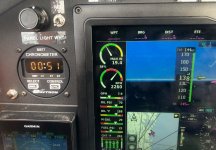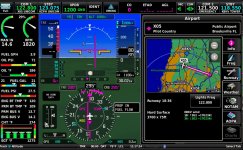I´m testing a "new" feature using the G3Xt Advanced Gauge Configuration, a Warning for ICE, using the fuel flow and airspeed.
Flying in IMC or at night makes it more difficult to detect ICE and it could be handy to have an alarm.
The idea is based on the fact that ICE will slow the aircraft down if power setting is fixed.
My normal TAS is >160 kt and therefore I have choosen to set the airspeed threshold to 145 kt. This setting may change.
Fuel flow in normal level flight in my plane will in most cases be between 7-11 gph. Climb and decent will be on the outside of this range.
As there is no standard label in the G3X system, I have choosen to present the ICE alarm on the rpm meter as RED range.
My engine is a standard 180 hp IO-360. Fuel flow in this case is a representation of engine power where 7 USG is about 50% and 11 USG is 75%.
An alarm will be triggerd if Fluel flow is between 7-11 gph and airspeed <145 kt and altitude above 2000 ft GND and after a time delay of 60 s.
Fuel flow below 7 gph or above 11 gph or airspeed above 145 kt or altitude below 2000 ft GND will not trigger the ICE alarm.
Flying in icing condition is dangerous and have taken down aircrafts. Settings used in this example may not be safe.
Testing is ongoing with only a few hours flown.
Configuration:
On the fuel flow Gauge Display, Edit Gauge Marking.
- set: Invisible range*
- set: Minimum: 7 gph
- set: Maximum: 11 gph
- set: Mode: Set Logic Signal
- set: Signal: 1 (or other that is not used)
On the Logic Signal Configuration page and signal 1 (or other that is not used).
- set: Time delay 60 s
- set: Airspeed threshold: True Airspeed / Below/ 145 kt
- set: Altitude threshold: Height AGL/ Above/ 2000 ft
On the rpm Gauge Display, Edit Gauge Marking.
- set: Red Range + Alert
- set: Minimum: 1500 rpm
- set: Maximum 2100 rpm
- set: Mode: Require Logic Signal Set
- set: Signal: 1 (or other that is not used)
Good Luck
Flying in IMC or at night makes it more difficult to detect ICE and it could be handy to have an alarm.
The idea is based on the fact that ICE will slow the aircraft down if power setting is fixed.
My normal TAS is >160 kt and therefore I have choosen to set the airspeed threshold to 145 kt. This setting may change.
Fuel flow in normal level flight in my plane will in most cases be between 7-11 gph. Climb and decent will be on the outside of this range.
As there is no standard label in the G3X system, I have choosen to present the ICE alarm on the rpm meter as RED range.
My engine is a standard 180 hp IO-360. Fuel flow in this case is a representation of engine power where 7 USG is about 50% and 11 USG is 75%.
An alarm will be triggerd if Fluel flow is between 7-11 gph and airspeed <145 kt and altitude above 2000 ft GND and after a time delay of 60 s.
Fuel flow below 7 gph or above 11 gph or airspeed above 145 kt or altitude below 2000 ft GND will not trigger the ICE alarm.
Flying in icing condition is dangerous and have taken down aircrafts. Settings used in this example may not be safe.
Testing is ongoing with only a few hours flown.
Configuration:
On the fuel flow Gauge Display, Edit Gauge Marking.
- set: Invisible range*
- set: Minimum: 7 gph
- set: Maximum: 11 gph
- set: Mode: Set Logic Signal
- set: Signal: 1 (or other that is not used)
On the Logic Signal Configuration page and signal 1 (or other that is not used).
- set: Time delay 60 s
- set: Airspeed threshold: True Airspeed / Below/ 145 kt
- set: Altitude threshold: Height AGL/ Above/ 2000 ft
On the rpm Gauge Display, Edit Gauge Marking.
- set: Red Range + Alert
- set: Minimum: 1500 rpm
- set: Maximum 2100 rpm
- set: Mode: Require Logic Signal Set
- set: Signal: 1 (or other that is not used)
Good Luck






